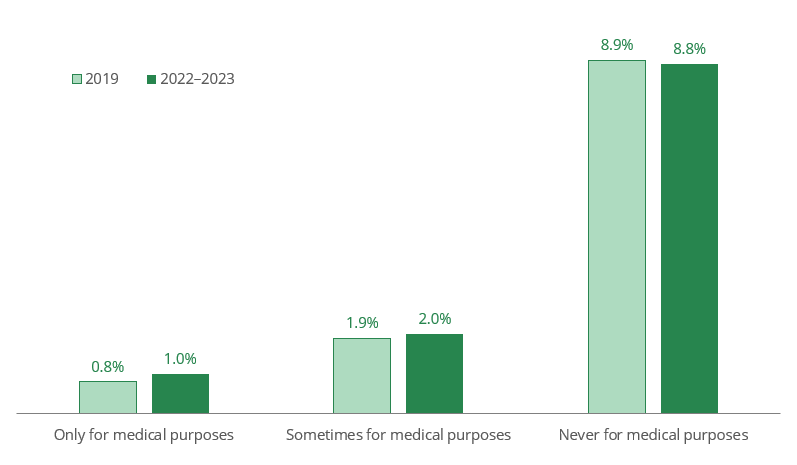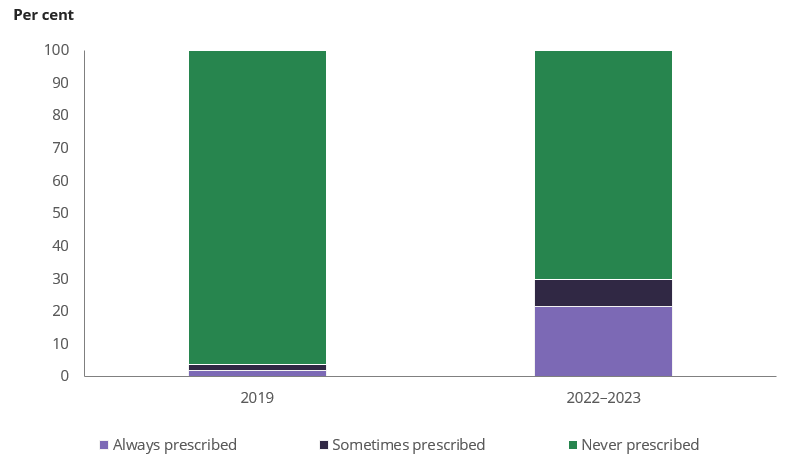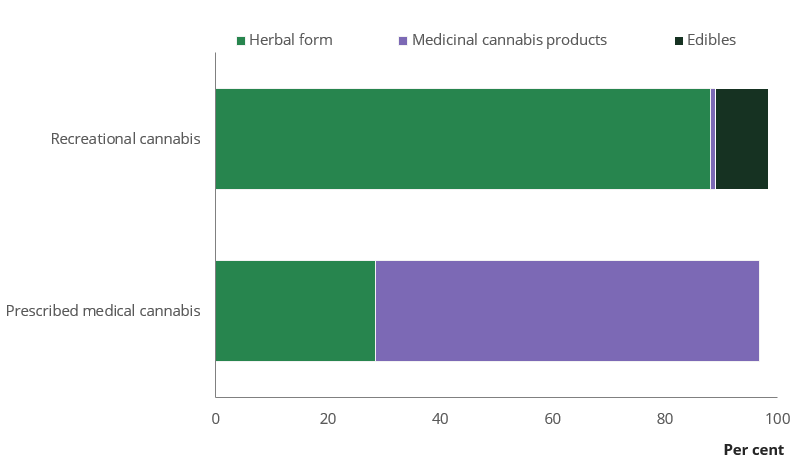More people are accessing medical cannabis with a prescription
Medical cannabis in Australia
Medical cannabis access was made legal in Australia in 2016. This means that prescribed cannabis products were made legal to access and use. Medical cannabis generally refers to medical products that contain Tetrahydrocannabinol (THC) or Cannabidiol (CBD) (Healthdirect 2022).
Medical cannabis prescriptions in Australia
Medical cannabis prescribing went through substantial changes in 2021. These changes were designed to improve accessibility, by making it easier for prescribers to be authorised to prescribe medical cannabis, and making it easier for patients to change to different medical cannabis products (NPS MedicineWise 2022). Changes between 2019 and 2022–2023 should be interpreted with this in mind.
Use of cannabis for medical purposes
This report includes results for people who reported using cannabis for medical purposes. This may include cases where the respondent has received a diagnosis and prescription from a medical professional, as well as cases where the respondent has used cannabis for self-determined medical purposes.
For information on cannabis use in the NDSHS outside of medical use, see this report .
In 2022–2023, 3.0% of people in Australia had used cannabis for medical purposes in the previous 12 months, equating to around 700,000 people. One in 3 of those people (1.0% nationally or 200,000 people) had never used cannabis for any other purpose. This was a small increase from 2019, but the total number of people in Australia using cannabis for medical purposes did not change substantially (Figure 1).

Source: NDSHS 2022–2023, Table 8.1.
However, the number of people receiving prescriptions for their medical cannabis increased substantially. In 2019, only 1 in 50 people (1.8%*) who used cannabis for medical purposes had always had it prescribed by a doctor. In 2022–2023, this increased ten-fold: 1 in 5 people (22%) had always had their medical cannabis prescribed by a doctor.
* Estimate has a relative standard error between 25% and 50% and should be interpreted with caution.
This means there are more people accessing medical cannabis through medical professionals rather than deciding to use cannabis for medical purposes without having a prescription, potentially reflecting better accessibility to medical cannabis prescriptions. However, prescriptions are still in the minority. In 2022–2023, 7 in 10 people (70%) who used cannabis exclusively for medical purposes in the previous 12 months did so without a prescription (Figure 2).

1. Includes both prescribed and non‑prescribed marijuana/cannabis.
Source: NDSHS 2022–2023, Table 8.3.
What is medical cannabis being prescribed to treat?
The NDSHS does not contain a full assessment of people’s health, so it is not possible to know exactly what medical cannabis is being prescribed for. However, there is some information captured about the health conditions that people live with, which may impact their use of medical cannabis.
Medical cannabis is most often prescribed for chronic pain, but it is also used to treat anxiety, as well as cancer-related pain and nausea (Healthdirect 2022). This was reflected in the NDSHS. Among those who had used prescribed medical cannabis:
- 43% reported being diagnosed or treated for chronic pain, much higher than the 10.7% of people diagnosed or treated for chronic pain nationally.
- 49% had an anxiety disorder, compared with 12.9% nationally.
- *6.2% had some form of cancer, compared with 3.7% nationally.
* Estimate has a relative standard error between 25% and 50% and should be interpreted with caution.
Some other illnesses were more likely to be experienced by people who used prescribed medical cannabis:
- Depression (47% compared with 13.3% nationally)
- Other major illness (22% compared with 6.1% nationally)
Are people using medical cannabis products?
Generally, people were most likely to use herbal forms of cannabis (for example, cannabis bud, head, or leaf), followed by edible forms (for example, brownies, cookies, lollies) and medicinal cannabis products (for example, pharmaceutical CBD/THC oil).
People who used cannabis for medical purposes and had it prescribed by a doctor mainly used medicinal cannabis products (68%), whereas only 1.0% of people who used cannabis recreationally mainly used medical cannabis products (Figure 3).

Note: Forms with less than 5% total have been excluded for data quality purposes. Totals will not sum to 100%.
Source: NDSHS 2022–2023, Table 8.9.


